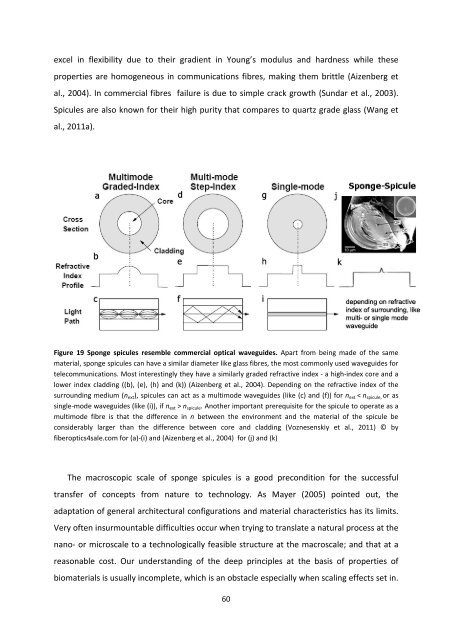MASTER THESIS Biomimetic potential of sponge ... - IAP/TU Wien
MASTER THESIS Biomimetic potential of sponge ... - IAP/TU Wien
MASTER THESIS Biomimetic potential of sponge ... - IAP/TU Wien
You also want an ePaper? Increase the reach of your titles
YUMPU automatically turns print PDFs into web optimized ePapers that Google loves.
excel in flexibility due to their gradient in Young’s modulus and hardness while these<br />
properties are homogeneous in communications fibres, making them brittle (Aizenberg et<br />
al., 2004). In commercial fibres failure is due to simple crack growth (Sundar et al., 2003).<br />
Spicules are also known for their high purity that compares to quartz grade glass (Wang et<br />
al., 2011a).<br />
Figure 19 Sponge spicules resemble commercial optical waveguides. Apart from being made <strong>of</strong> the same<br />
material, <strong>sponge</strong> spicules can have a similar diameter like glass fibres, the most commonly used waveguides for<br />
telecommunications. Most interestingly they have a similarly graded refractive index - a high-index core and a<br />
lower index cladding ((b), (e), (h) and (k)) (Aizenberg et al., 2004). Depending on the refractive index <strong>of</strong> the<br />
surrounding medium (n ext ), spicules can act as a multimode waveguides (like (c) and (f)) for n ext < n spicule, or as<br />
single-mode waveguides (like (i)), if n ext > n spicule . Another important prerequisite for the spicule to operate as a<br />
multimode fibre is that the difference in n between the environment and the material <strong>of</strong> the spicule be<br />
considerably larger than the difference between core and cladding (Voznesenskiy et al., 2011) © by<br />
fiberoptics4sale.com for (a)-(i) and (Aizenberg et al., 2004) for (j) and (k)<br />
The macroscopic scale <strong>of</strong> <strong>sponge</strong> spicules is a good precondition for the successful<br />
transfer <strong>of</strong> concepts from nature to technology. As Mayer (2005) pointed out, the<br />
adaptation <strong>of</strong> general architectural configurations and material characteristics has its limits.<br />
Very <strong>of</strong>ten insurmountable difficulties occur when trying to translate a natural process at the<br />
nano- or microscale to a technologically feasible structure at the macroscale; and that at a<br />
reasonable cost. Our understanding <strong>of</strong> the deep principles at the basis <strong>of</strong> properties <strong>of</strong><br />
biomaterials is usually incomplete, which is an obstacle especially when scaling effects set in.<br />
60

















